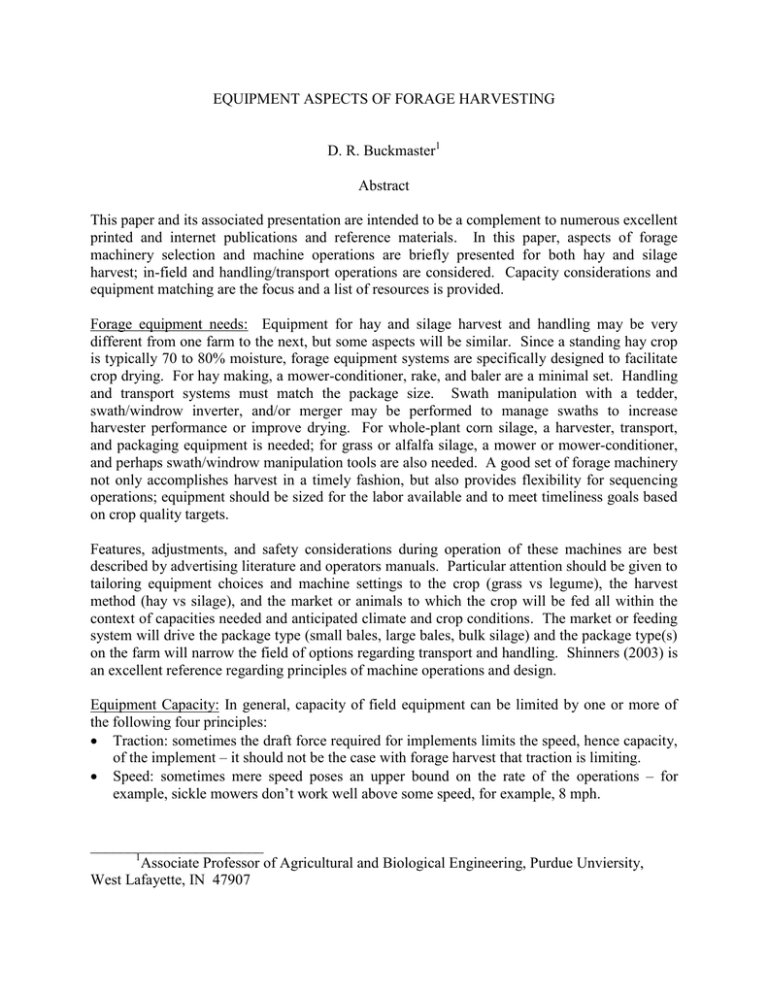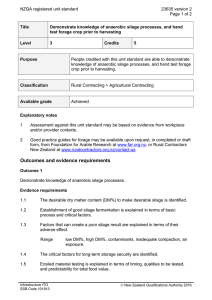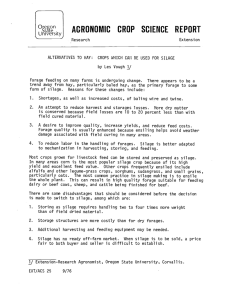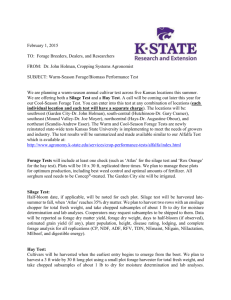Equipment ASpects of Forage Harvesting
advertisement

EQUIPMENT ASPECTS OF FORAGE HARVESTING D. R. Buckmaster1 Abstract This paper and its associated presentation are intended to be a complement to numerous excellent printed and internet publications and reference materials. In this paper, aspects of forage machinery selection and machine operations are briefly presented for both hay and silage harvest; in-field and handling/transport operations are considered. Capacity considerations and equipment matching are the focus and a list of resources is provided. Forage equipment needs: Equipment for hay and silage harvest and handling may be very different from one farm to the next, but some aspects will be similar. Since a standing hay crop is typically 70 to 80% moisture, forage equipment systems are specifically designed to facilitate crop drying. For hay making, a mower-conditioner, rake, and baler are a minimal set. Handling and transport systems must match the package size. Swath manipulation with a tedder, swath/windrow inverter, and/or merger may be performed to manage swaths to increase harvester performance or improve drying. For whole-plant corn silage, a harvester, transport, and packaging equipment is needed; for grass or alfalfa silage, a mower or mower-conditioner, and perhaps swath/windrow manipulation tools are also needed. A good set of forage machinery not only accomplishes harvest in a timely fashion, but also provides flexibility for sequencing operations; equipment should be sized for the labor available and to meet timeliness goals based on crop quality targets. Features, adjustments, and safety considerations during operation of these machines are best described by advertising literature and operators manuals. Particular attention should be given to tailoring equipment choices and machine settings to the crop (grass vs legume), the harvest method (hay vs silage), and the market or animals to which the crop will be fed all within the context of capacities needed and anticipated climate and crop conditions. The market or feeding system will drive the package type (small bales, large bales, bulk silage) and the package type(s) on the farm will narrow the field of options regarding transport and handling. Shinners (2003) is an excellent reference regarding principles of machine operations and design. Equipment Capacity: In general, capacity of field equipment can be limited by one or more of the following four principles: Traction: sometimes the draft force required for implements limits the speed, hence capacity, of the implement – it should not be the case with forage harvest that traction is limiting. Speed: sometimes mere speed poses an upper bound on the rate of the operations – for example, sickle mowers don’t work well above some speed, for example, 8 mph. _______________________ 1 Associate Professor of Agricultural and Biological Engineering, Purdue Unviersity, West Lafayette, IN 47907 Throughput capacity: even if there were plenty of power to the implement, some implements have a “throat” through which crop must flow and this can limit capacity – balers and forage harvesters have this limitation. Power: if there is insufficient power with a particular harvester or tillage implement, the lack of power can limit speed and/or throughput. Balers and forage harvesters can have this limitation. There is a fifth element in capacity evaluation when harvesters must interact with transporters and those transporters must interact with unloading sites; this interaction can limit system capacity to levels lower than capacities of individual machines within the system. Good selection of forage machinery doesn’t require calculation, but the insight from a mathematical treatment of the topic can certainly improve the quality of these expensive investment decisions. For many machines, thinking of capacity as field capacity (area covering rate) for field going machinery is most appropriate; it is simply a function of speed, width, and field efficiency (which accounts for overlap, turning, etc.): Carea, ac/h = (Smph Wft Edecimal)/8.25 A rake, swath merger, or tedder fits this approach well because power would rarely be a limitation. Speed may be a limit (for example, you can go too fast for some devices or perhaps any faster and safety becomes compromised), but the capacity is simply related to width and speed. For some machines, it is not area capacity which is of concern, but, rather, material capacity which incorporates crop yield: Cmaterial, t/h = (Smph Wft Edecimal Ytons/ac)/8.25 In harvester or baler operations, it is material capacity and the related power requirement which often limit capacity. Manufacturers don’t generally report material capacity limits, but equipment operators will soon find their operating comfort limit which can be related to throughput capacity either limited by the power available or the machine throughput limit. In a well matched tractor-harvester pair, power and throughput should provide a similar limit (that is, there is neither excess capacity “wishing” for more power nor excess power “wishing” for a bigger implement). For mowers and mower conditioners, the capacity-limiting factor is not always clear or consistent. If a tractor and disc mower pair has plenty of power for a low yield crop, capacity may be speed limited. In different crop conditions, the throughput of the conditioner may limit speed, hence capacity. In yet different crop conditions, the power for cutting may be high and the reason the operator cannot go faster (particularly up-hill) is insufficient power. Proper machine selection is a balance of machine capacity (area or material rate) to the capacity needed. The capacity needed is a function of the area (or total amount) to be harvested as well as the time constraints for that harvest which include calendar days (D), hours per day for this particular operation (H), and the probability (or likelihood) that a given day is suitable for this particular operation (P, often referred to as probability of a working day). Using the area basis: Carea,needed, ac/h = Aacres/(Ddays Hh/day Pdecimal) As with capacity from a particular machine, the material capacity needed incorporates yield: Cmaterial,needed, tons/h = (Aacres Ytons/ac)/(Ddays Hh/day Pdecimal) Capacity example 1: Consider a situation where 120 acres of haycrop should be mowed within 14 calendar days and the operator is willing to mow for up to 6 hours each day during a time of the year for which 30% of the days seem suitable for mowing. Suppose the anticipated mowing speed is 7 mph and the field efficiency of mowing (taking into consideration overlap, turning, etc.) is 0.8. Carea,needed, ac/h = Aacres/(Ddays Hh/day Pdecimal) = 120 /(14x6x0.3) = 4.8 ac/h Matching this need with the capacity from a mower, we have: Carea, ac/h = (Smph Wft Edecimal)/8.25 = 4.8 ac/hour = (7xWx0.8)/8.25 W = 7 ft, so a 7 ft mower would be sufficient. Where do the numbers for situations like this come from? Typical speeds would come from experience or an informed salesperson. Probability of a working values are tabulated in different sources, but most forage producers likely have a reasonable feel for values. The other values are farm specific. Capacity example 2: Considering the same farm with 120 acres of haycrop …raking likely needs to occur in less time within the day because baling also needs to happen that day. Although the mower was sized with 14 calendar days in mind and the 30% probability of a working day, we could likely assume something like the raking needs to take place on a total of 5 days with only 2 hours available each raking day. If this is the case, the capacity needed is the 120 acres in 10 hours or 12 acres/hour. With an assumed raking speed (e.g., 8 mph) and raking field efficiency (0.8), the width needed is: Carea, ac/h = (Smph Wft Edecimal)/8.25 = 12 ac/hour = (8xWx0.8)/8.25 W = 17 ft, so a 15 to 20 ft rake would be needed. Capacity example 3: Continuing with the same farm situation, let’s consider the baler. If there was a 7 ft mower and a 20 ft rake, perhaps each baler windrow came from about 20 ft of field width collected by the rake. Or perhaps, the rake made two windrows each from about 10 ft of field width. Either way, the baler capacity requirement isn’t really set by area but is more determined by throughput capacity and power available. Just as an example, suppose the goal with the 120 acres, which has a per-cutting yield of 3 tons/acre, is to get it baled on 5 days (which might fall over a 14+ day calendar window) with up to 5 hours devoted to baling on a “baling day”. This means the total of 360 tons (120x3) needs to be baled in about 25 (5x5) hours. This capacity of 14 tons/hour might mean more to some operators expressed as 28 1000 lb bales/hour or 480 60 lb small bales/hour. A capacity like this requires both a baler with the capacity and a tractor with enough horsepower. The capacity to transport and put away the forage into storage cannot be ignored either. It may be that these considerations force a stretch to the harvest window. The principle illustrated through these examples is that the capacity of machines in a “good set” of forage equipment (mower, rake, baler) are not likely the same. The hours available for the operations dictate the capacities needed. If forage equipment manufacturers reported material capacities of equipment, selecting machinery might be easier, but recognize that this capacity is very much a function of crop type and conditions. Informed dealers should be able to help match implements to capacity needs and match tractors to those implements. Equipment matching: For haymaking equipment, the key matching considerations are related to capacity needed, power needed, and having transport and logistics which can keep up with the harvest. The examples above illustrate the interrelationships, but good operators will consider creative solutions. Use of preservatives can extend the baling hours in a day. Multiple rakes or balers may be required to “match” larger mowers. Handling systems may need to be highly mechanized to keep the forage from weather damage after packaging. For silage making, equipment matching is very much driven by harvest-time logistics. Sufficient wagons or trucks are needed to keep up with harvester capacity. Blower size and power, bagger size and power, or bunker packing tractor weight must be sufficient to keep up with harvester capacity. If silage is baled, then the capacity to transport and wrap or seal bales must match so there is no more than a couple hour delay between packaging and sealing. Table 1. Approximate sizing of silage harvesting equipment to match harvester power (Buckmaster, 2009). Harvester Power (hp) Approximate Power Power Bunker Packing system capacity, needed to a needed to Tractor Weight1 (with transport nonblower (hp) a bagger 1 tractor, good limiting (tons/h) (hp) packing practices, lb) Haycrop silage PHHhp PHH/4 0.5(PHH) 0.4(PHH) 21,500 + 83(PHH) Example, PHH=250 hp 62 tons/h 125 hp 100 hp 42,000 lb Corn silage PHChp PHC/2.5 0.6(PHC) 0.4(PHC) 27,000 + 105(PHC) Example, PHH=300 hp 120 tons/h 180 hp 120 hp 58,000 lb2 1 3 Assuming 65% moisture, 6” layers to reach 16 lb DM/ft target (Holmes and Muck, 2002). 2 Most tractor manufacturer warranties end when tractor ballast weight exceeds about 150 lb/PTO hp. This 58,000 lb tractor would need to be a 390 hp or larger 4WD unit – if one wasn’t available, two lighter packing tractors would be needed. Silage equipment matching was addressed by Buckmaster (2009). A summary of that work is in Table 1. Using cycle analysis, the number of transport units required to keep the forage harvester from having idle time was also estimated (Buckmaster, 2009). Resulting equations were: Haycrop silage, with dump cart: Nt,req'd = 0.44 + 0.061[PHHhp*Dt,mi/(Vt,tDM*St,mph)] Haycrop silage, direct to transporters: Nt,req'd = 1.50 + 0.061[PHHhp*Dt,mi/(Vt,tDM*St,mph)] Corn silage, with dump cart: Nt,req'd = 0.44 + 0.098[PHChp*Dt,mi/(Vt,tDM*St,mph)] Corn silage, direct to transporters: Nt,req'd = 1.50 + 0.098[PHChp*Dt,mi/(Vt,tDM*St,mph)] Where: Nt,req’d = number of transport units required PHC = power of the forage harvester in to keep the harvester busy (must be whole-plant corn silage rounded!) Dt = round trip transport distance, miles PHH = power of the forage harvester in Vt = capacity of the transporters, tons DM haycrop silage St = speed of the transport units, mph Literature Cited: Buckmaster, D.R. 2009. Equipment matching for silage harvest. Appl. Eng. In Agr. 25(1):31-36. Holmes and Muck. 2002. Documentation of bunker silo silage density calculator. Univ. of Wisconsin, Madison. http://www.uwex.edu/ces/crops/uwforage/bunkdens‐Doc.PDF. Accessed 30 Oct. 2012. Shinners, K.J. 2003. Engineering principles of silage harvesting equipment. Chapter 8 in: Silage Science and Technology. Buxton, Muck, and Harrison, eds. Amer. Soc. of Agronomy. Related Educational Internet Sites: UW Madison forage website: http://www.uwex.edu/ces/crops/uwforage/storage.htm Integrated Farming System Model reference manual: http://www.ars.usda.gov/main/docs.htm?docid=8519#Reference Encyclopedia entry on Forage Harvesting Systems: http://books.google.com/books?id=fCRpUZzT2hMC&pg=PA358&dq=forage+harvesting+sy stems+buckmaster+encyclopedia&hl=en&sa=X&ei=61aPUKaRNKX50gGJqYCwDQ&ved= 0CC8Q6AEwAA Simple primer on haying equipment: http://counties.cce.cornell.edu/washington/Ag/Haymanual/Hay%20Manual/4-HayMachinery/Hay%20Making%20Equipment.pdf Author’s outreach page: https://engineering.purdue.edu/~dbuckmas/index.html Penn State forage publications online: http://pubs.cas.psu.edu/PubSubject.asp?varSubject=Forage, Pasture, and Silage For historical perspective … 1919 Hay: http://books.google.com/books?id=Mu9Ye_HFbucC For historical perspective … 1903 Silage: http://books.google.com/books?id=kTdEAAAAYAAJ Haymaking 101, A Deere publication: http://www.deere.com/en_US/docs/zmags/agriculture/online_brochures/hay_forage/haym asters/haymasters_zmags.html New Holland Haymakers Handbook (excerpts only online): http://agriculture.newholland.com/us/en/information-center/haymakershandbook/Pages/default.aspx EQUIPMENT ASPECTS OF FORAGE HARVESTING D. R. Buckmaster1 Equipment for hay and silage harvest and handling may be very different from one farm to the next, but some aspects will be similar. Since a standing hay crop is typically 70 to 80% moisture, forage equipment systems are specifically designed to facilitate crop drying. Particular attention should be given to tailoring equipment choices and machine settings to the crop (grass vs. legume), the harvest method (hay vs. silage), and the market or animals to which the crop will be fed all within the context of capacities needed and anticipated climate and crop conditions. The market or feeding system will drive the package type (small bales, large bales, bulk silage) and the package type(s) on the farm will narrow the field of options regarding transport and handling. A good set of forage machinery not only accomplishes harvest in a timely fashion, but also provides flexibility for sequencing operations; equipment should be sized for the labor available and to meet timeliness goals based on crop quality targets. The capacity of machines in a “good set” of forage equipment (mower, rake, baler) are not likely the same because different hours available for the operations dictate the capacities needed. Key matching considerations are related to capacity needed, power needed, and having transport and logistics which can keep up with the harvest. Capacity considerations and equipment matching are discussed and a list of resources is provided. _______________________ 1 Associate Professor of Agricultural and Biological Engineering, Purdue Unviersity, West Lafayette, IN 47907







